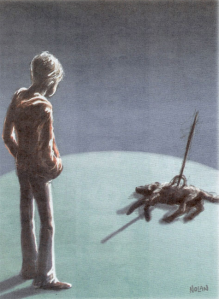 Our last lesson was a lesson on crossover books. I was honestly a bit sad that this was our last class, and that is something that does not happen very often, I can assure you of that. This class has taught me to see beyond books in both positive and negative ways. I am really fond of youth literature, I like learning about why these books are interesting for my students and why. On top of that, I loved to be able to read some of these books that I had read before and not feeling guilty about that for a change, because this time it was really for educational purposes instead of sogging my time away with reading books.
Our last lesson was a lesson on crossover books. I was honestly a bit sad that this was our last class, and that is something that does not happen very often, I can assure you of that. This class has taught me to see beyond books in both positive and negative ways. I am really fond of youth literature, I like learning about why these books are interesting for my students and why. On top of that, I loved to be able to read some of these books that I had read before and not feeling guilty about that for a change, because this time it was really for educational purposes instead of sogging my time away with reading books.
The theme crossover books did not ring any bells with me. It turned out to be a book that appeals to both adults and younger readers. Out of the list I immediately chose The Curious Incident of the Dog in the Night-time. I had read this book before and immediately fell in love with it. The writing style, the puzzles and the mind of the protagonist suck me into the book every time I read it and I took the opportunity to talk through this book with my classmates and see if they feel the same about this book and share experiences.
It turns out that not everybody feels the same about this book. I can get that, you either love it or hate it. Some of the students just could not adapt to the style of the book and the way of thinking of the protagonist, while others started to develop an aversion to the colours brown and yellow and started counting red cars on the way to school. We are all lucky to have a different taste, of course, but it was interesting to see that not everybody fell in love with the book like I did.
We start a journey with young Christopher, who’s neighbors’ dog has died and he is persistent on finding out who killed the dog. We view Asperger’s disease through his point of view and have to separate the crap from the real clues in this book. He provides us with a lot of nonsense next to vital information, and it is up to us to keep up with the story. Christopher is also trying to find himself in a world that is spinning around him. He finds out about ‘doing sex with eachother’ , feels that his body is growing and changing but he cannot quite keep up with all of that. Instead he just ignores what is happening and just focuses on playing Sherlock Holmes for his next door neighbor while his father is telling him to keep his nose out of other people’s business.
In this book, we come across the absence of parents again. The father is present, but only yells at him for doing things wrong instead of really caring for him. Then there is the fact that he has lied to his son that his mother has died while she really has cheated on him and moved away to avoid complicated situations. We also see that even at a school for special kids, Christopher is an outsider. He gets yelled at for being a ‘spazzer’ and an idiot, while Christopher sees them as the retards of the world.
The other books were also books that would be recommended to both adults and young readers. They offer a great story to both readers, but need a critical eye to see between the lines of the story. They all contain humor, action and an attractive storyline to grip both young and older readers.
The age group that I would recommend this book to is that of the age of about 12. It speaks to the imagination and you get sucked into the story the moment you start reading. In the first few pages you immediately find out whether you will finish this book or not. To me, it was a revelation and a lovely peek into the mind of a boy with autism.



 Teaching your teenage daughter how to become completely codependent and how she most certainly should not have a social life for her own? Twilight is your book. Falling in love with a vampire that forbids you to go out on your own and is willing to flat your tires for it is of course everybody’s dream nowadays, and you better keep your mouth shut or he will let you bleed to death in your sleep.
Teaching your teenage daughter how to become completely codependent and how she most certainly should not have a social life for her own? Twilight is your book. Falling in love with a vampire that forbids you to go out on your own and is willing to flat your tires for it is of course everybody’s dream nowadays, and you better keep your mouth shut or he will let you bleed to death in your sleep.